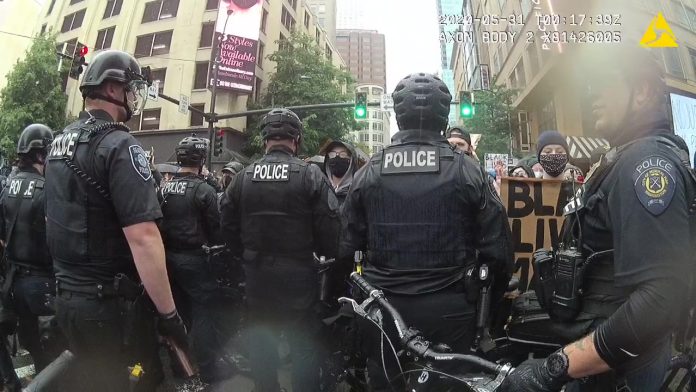
New footage shows how police kettled protesters, trapping them in a corridor of violence in the early days of 2020 protests.
Newly obtained body worn video and helicopter surveillance footage shine new light on the crowd control tactics of the Seattle Police Department (SPD) during the summer protests of 2020. It shows SPD corralling people into Westlake Park on May 31, and organizing to herd protesters directly to the East Precinct on June 1, where they would be confronted by an SPD who later stated they were preparing for “battle.” Multiple officers then verbalized they had “fun” after deploying chemical weapons.
SPD’s commander in the field was then promoted, and appointed to the Office of Inspector General’s Sentinel Event Review, which is responsible for analyzing police use-of-force incidents that caused injuries or deaths and learning lessons to prevent them in the future.
The documentation shows that while a recent lawsuit stemming from SPD’s excessive force in 2020 settled for $10 million, not including an additional $30 million in legal expenses fighting the case, a full accounting of the department’s 2020 conduct is still far from resolved.
The ACLU of Washington declined to comment on the specific circumstances within this story due to ongoing litigation with the city stemming from the 2020 protests. However, in general, Enoka Herat, Policing and Immigration Policy Program Director noted that “Police should prioritize protecting everyone’s civil rights and liberties, even when protestors express views that are critical of the department, and force cannot be used to silence dissent.”
Despite the historic magnitude of financial costs to the city across multiple legal settlements, in the three-plus years since the summer of 2020, the department internally has rarely found any of its conduct to be worthy of punishment beyond a handful of oral and written reprimands.
Only four out of 133, or 3%, of investigations completed by the Seattle Office of Police Accountability (OPA) into SPD’s 2020 protest conduct have resulted in officer suspensions without pay, according to a review of OPA files. SPD declined to comment for this story.
“Because – Don’t ever forget the power of Because.”
Following widespread protests on May 30, 2020 Mayor Jenny Durkan declared a curfew within city limits after 5pm for the following two days, May 31 and June 1, 2020.
On May 31, videos show SPD luring protesters into Westlake Park, trapping them in, and using the pretext of Mayor Durkan’s curfew order to forcibly herd the crowd through the streets of Seattle, under threat of arrest and violence.
Initially, SPD had formed a cordon around Westlake Park to exclude the public from entering Seattle’s downtown core.
Newly released body worn video footage and King County Sheriff video footage show SPD directives in the field were diametrically opposed to their initial stated goal of establishing a restricted cordon around downtown. (See the video below compiling some of the highlights from that footage.)
As an SPD SWAT team sat in their Suburban SUV, trailing protesters around Capitol Hill, Officer Adam Losleben’s camera caught someone in the car saying, “Yesterday they wanted to drive everybody East, now they want to drive ‘em back downtown,” directly into the restricted Public Safety Zone established by SPD. The comment was made at 5:03pm, minutes after Mayor Durkan’s curfew order was in effect prohibiting gathering.
As crowds approached officers, over the radio, a plan began to formalize.
At 6:01pm approximately 1,500 people were “denied downtown access.” Eight minutes later the crowd size on Capitol Hill swelled to between 2,000-3,000 people according to SPD Computer Aided Dispatch (CAD) records.
At 8:00pm Captain Matt Allen gave warnings to the crowd about the mayor’s curfew order. At 8:01pm CAD records state that “People going back into restricted area around Westlake, security details copied.”
Captain Allen’s written statement notes that, “While we were at this location, I believe I had one or more telephone conversations with Assistant Chief Mahaffey concerning the group’s efforts to head downtown and I believe we discussed the Mayor’s Curfew Order. At approximately 1943 hours [7:43pm] I issued another verbal warning about the Mayor’s Curfew order via our PA system.”
At 8:07pm, while Mayor Durkan’s curfew order was in effect, SPD Lt. John Brooks tells the crowd, “We’re going to let you guys march back down to Westlake.”
At 8:16pm CAD records state that SPD was actively “trying to move group back to Westlake [Park].” Three minutes later, SPD Sgt. William Geoghagan asked over the radio, “Are we trying to draw the crowd back into Westlake, or are we holding them here?”
Then Lt. John Brooks, chirped over the radio: “Westlake. 216 [Brooks’ call-sign] for all units, allow the crowd to go back to Westlake. We’ll coalesce all our resources there, and decide the plan from that point.”
At this moment, King County Sheriff helicopter footage shows SPD opening their barricades, and allowing protesters to flow into Westlake Park and into the restricted Public Safety Zone. Once corralled, SPD appeared, not to disperse the crowd, but to trap them and herd them to a point about a mile away, up Pine Street, up Boren Avenue, then up Madison Street.
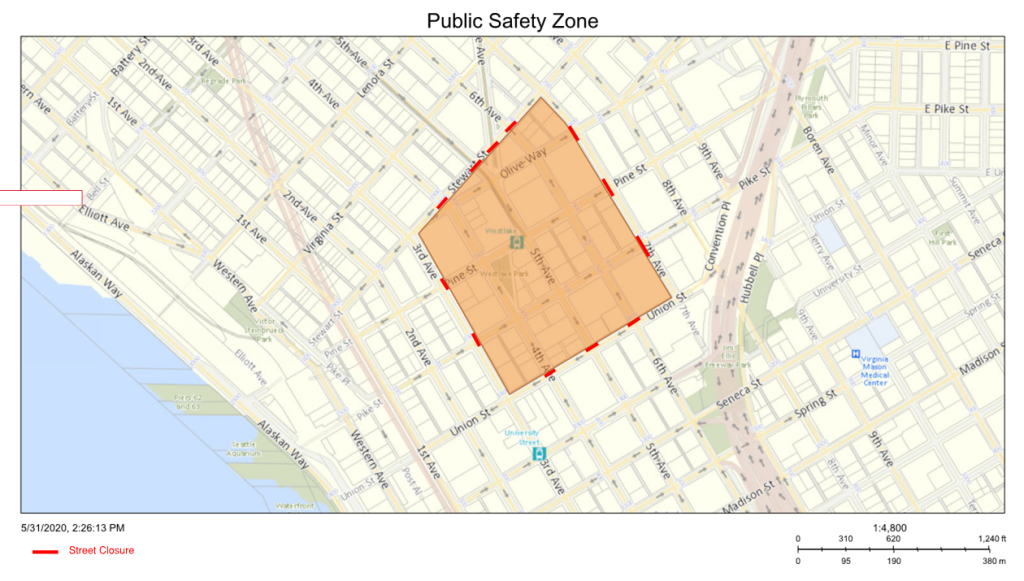
The route established essentially a dynamic corridor, ensnaring protesters along a continual up-hill climb with 200 feet of elevation gain between Westlake Park and the intersection of Boren Ave and Madison Street. SPD bike units “leapfrogged” each other ahead of protesters to block egress at intersections perpendicular to a planned route of travel established by SPD.
Brooks would later compose a uniquely long 73-page use of force statement, where he wrote, “Per the Mayor’s orders we attempted to keep the crowd to the east and out of the downtown core… It was recognized this was futile and the group was permitted to return to Westlake. We advised they must vacate the park at the direction of Mayor.”
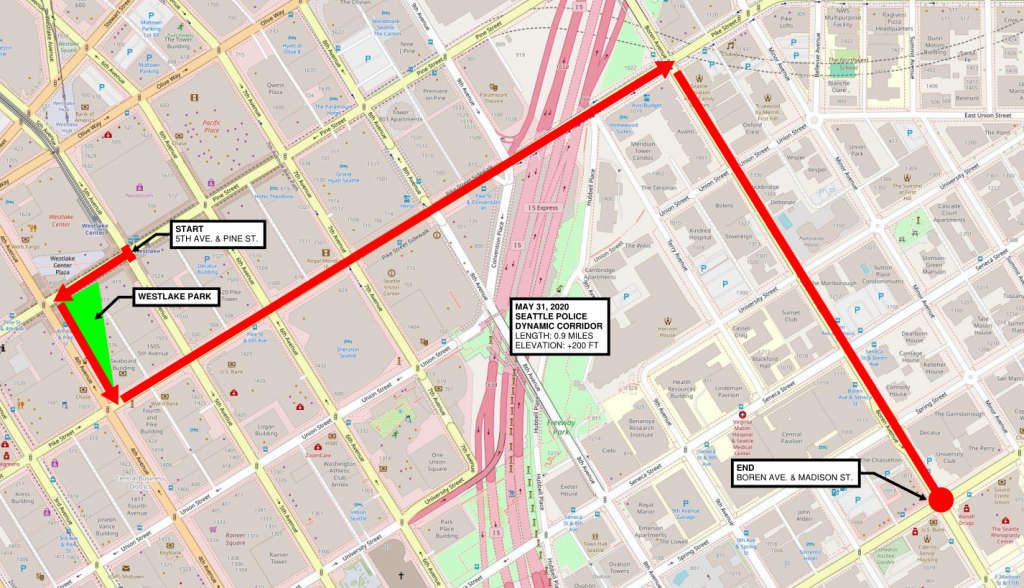
Yet, video evidence shows people freely leaving Westlake Park, then an SPD SWAT commander arbitrarily prevents their exit. “What are we supposed to do?!” Protesters yell. “They trapped us! […] Let us leave!”
A minute later, Captain Matt Allen states over the radio, “Car 21 to [Assistant Chief] Mahaffey, we are holding, we are not moving … property damage has subsided for now.”
When one SPD officer questioned, “Why don’t we just open up Pine [Street] and let them [protesters] out the same way they came in?” Acting Sergeant Aaron Johnson responded, “Because. Don’t ever forget the power of because.”
The next day, Johnson added, “All my team’s doing a great job, it’s just too bad they’re working for such a retard… that’d be me.”
Once the crowd of protesters were trapped within Westlake Park, SPD began to “prepare a corridor” to march protesters through a cattle run of SPD bike cops up Pike Street. At this stage, SPD Captain Matt Allen’s announcements in the field listed the sole justification for crowd dispersal as Durkan’s executive curfew order.
Within his written statement, Captain Allen wrote that he “spoke with Assistant Chief Mahaffey about the present situation via telephone. Based on our conversation, I understood that the Mayor wanted the Curfew Order enforced and we agreed that we needed to take further action to enforce it.”
Behind police lines, the Durkan administration’s actions appeared to contradict their public facing statements. The mayor’s office had previously told the public that, “The City does not intend to enforce the curfew, except for violations that result in public health and safety threats including fires, extensive property damage, and violence.”
Earlier in the day, Durkan’s legal counsel Michelle Chen, wrote in a text message (obtained via public records request) to Deputy Mayor Mike Fong: “until the curfew is effective at 5pm, there is no legal basis for SPD to disperse the crowds other than the stay home order and/ or reasonable suspicion that crimes are about to be committed. Chief wanted me to relay that to mayor that police won’t actually move on people until 5pm curfew.”
“Keep pushing ‘em”
As SPD began their operation to force protesters up Pike street, Lt. Brooks can be heard yelling over police radio, “Push the group! Push the group! If you have to, use OC! … Bikes move forward! … If you have to use munitions to gain space, do so.” Seemingly authorizing the use of force to allow SPD’s bike cops to move forward and prevent anyone from escaping SPD’s dynamic corridor.
In radio conversations between then Lt. Brooks and Lt. James Dyment, SPD continued to ensnare protesters along a dynamic route up to Boren Ave:
Lt. Dyment:” How far are we gonna push em?”
Lt. Brooks: “KEEP PUSHING ‘EM! Push to Boren then southbound.”
Instead of letting protesters funnel out of Westlake Park on their own volition, SPD commanders trapped them, marching them up Seattle’s steepest streets, allegedly because the “mayor wanted the curfew order enforced.”
According to SPD Use of Force Data, after drawing protesters into Westlake Park, contrary to the intent of Durkan’s curfew order, SPD then used pepper spray on protesters, made at least four arrests, and in one case, an “officers riot baton came into contact with [a Black male] subject’s face area,” according to use of force reports.
At 10:29pm then Deputy Mayor Mike Fong texted then SPD Assistant Chief Steve Hirjak: “How many folks left out there approx?”
Hirjak responded, “We reduced it down to under 100.”
Fong replied back, “Good work.”
As police departments like NYPD wage legal battles over their tactics of kettling and mass arrests, they may take a page out of SPD’s playbook. In lieu of arresting large groups of protesters, opting to corral them, then implementing a never-ending dynamic corridor to herd people through. This establishes a quasi-legal pathway to continually inflict violence on a population, telling them to disperse in the direction of travel, while police line the corridor and block alternate egress pathways, trapping people in a cyclical deja vu of dispersal orders, pushing and arrests.
As such, it calls into doubt whether such strategies are compatible with each person’s First Amendment rights.
Moving protesters to the East Precinct ultimately backfires
On the next day, June 1, 2020, SPD’s strategy took a different turn, instead of trapping protesters in Westlake Park and marching them up Boren Avenue, they deliberately herded protesters to 11th and Pine, directly to a hardened line of officers stationed in front of SPD’s East Precinct.
At about 5pm as Lt. Brooks stood in front of a crowd of five thousand people peacefully gathered at City Hall, he quipped, unsolicited, to Lt. Lora Alcantara, “Man, all we need is one thing… One thing happens and it’s gonna be…” The empty end to his sentence appeared pregnant with violent potential.
Alcantara chimed in, “If something pops up, we need to just push…..” She gestures with both her hands, throwing them forward at the crowd. “We would push with [OC] spray right?” as she points at a line of bike cops.
“Yep, yep, it does,” Brooks responds.
Cops seemed to like having Brooks around. “Earlier when he [Brooks] was telling us to deploy stuff [munitions] it was nice…..you know what I mean? … I’m recording….” Officer Losleben said in passing the day before.
According to Seattle Police Operations Center logs, by 5:40pm about 7,000 protesters had gathered in Westlake Park. As the crowd was hemmed in by SPD, a prolific protest speaker announced she had talked with Chief Best directly about marching to SPD’s East Precinct.
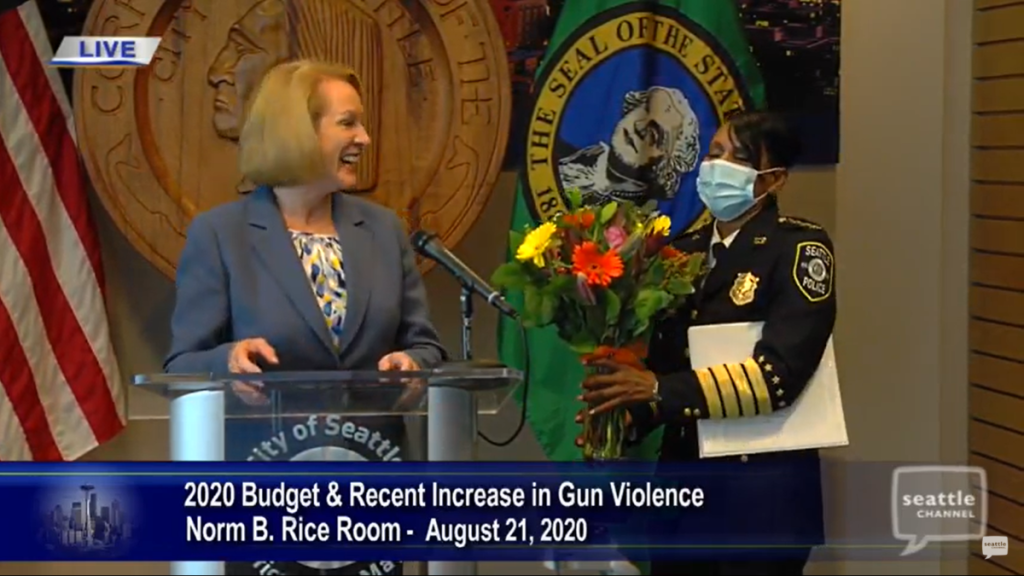
As SPD held protesters within Westlake Park, Lt. Brooks provided orders over the radio at 5:46pm, “For everyone, our plan is, once we get this set up, we’re gonna move this entire group up Pine [St] to the East Precinct.”
Instead of marching protesters against Seattle’s steepest hills, SPD would coalesce demonstrators around their precinct, to face an SPD who later stated they were preparing for a “battle,” and eventually attacking protesters with blast grenades, pepper spray, and CS tear gas canisters within the notorious Pink Umbrella incident that made national news.
Who ordered munitions deployed during the Pink Umbrella incident? According to OPA, that would be the man who ordered SPD to move protesters to the East Precinct in the first place, then Lt. John Brooks.
Brooks was found to have violated policy for ordering deployment of tear gas in the infamous “Pink Umbrella” incident on June 1, 2020 at the intersection of 11th and Pine. While the Office of Police Accountability (OPA) found him at fault, in a somewhat unusual move for such a high profile incident, Chief Adrian Diaz overruled the OPA case against Brooks.
In addition to exonerating Brooks for his role, Chief Diaz promoted him to Captain. The Office of Inspector General (OIG) then appointed him as a panelist to the OIG Sentinel Event Review (SER), giving him agency to direct the SER findings. OIG declined to comment for this story.
After OPA had completed its investigation into the June 1 incident, Brooks gave a presentation to then OPA director Andrew Myerberg and then Assistant City Attorney Amy Lowen. One of his presentation slides stated that “murders and rape compelled police action.” [No rapes or murders were reported at any Seattle protests between May 29 and June 1, 2020.]
According to records provided by SPD, Brooks appeared to give a similar presentation to the OIG SER about the Pink Umbrella incident. His presentation again repeated a false claim that “murders and rape compelled police action.”
In response to a public disclosure request, OIG claimed that no meeting minutes exist for the day when Brooks appeared to present to the panel.
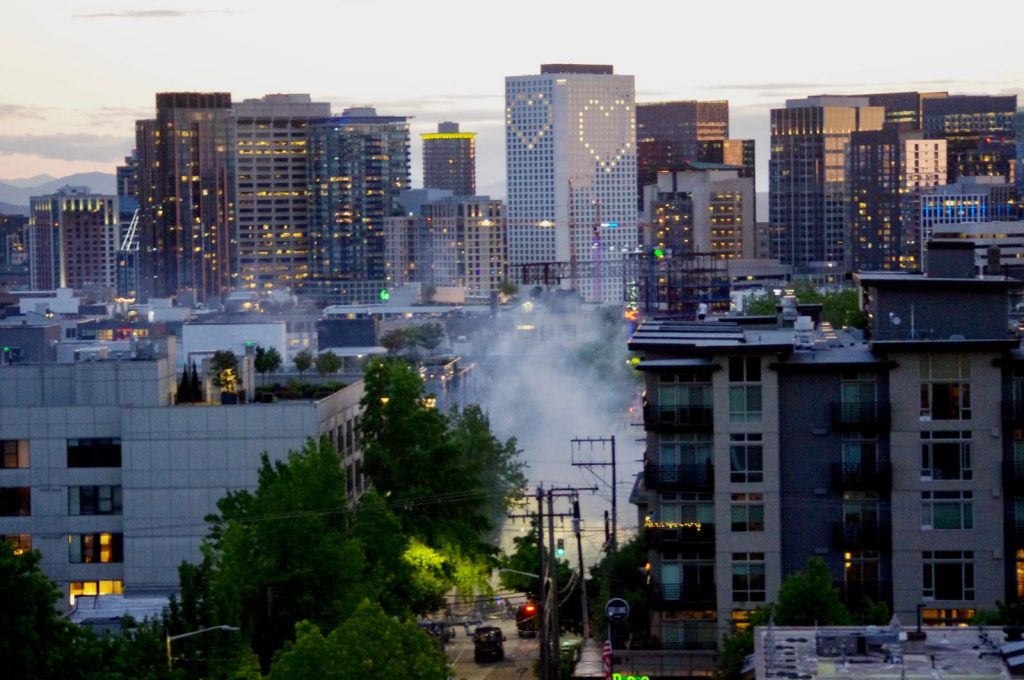
While OPA found that the June 1 crowd was “agitated but not openly violent, and the video did not depict any acts of violence like throwing objects” at the time SPD deployed tear gas and chemical agents, Assistant Chief Steve Hirjak texted Carmen Best at 9:05pm, “Just update that many thousand going hostile up east.” Best texted back “Copy.”
Hirjak then texted Best again at 9:44pm, “Prolonged attack on east precinct.”
At 10:07pm Hirjak texted SPD’s chief legal officer Rebecca Boatright, “Can we arrest organizers for riot or anything like that?”
Boatright texted back, “Let’s discuss. There is an RCW on rioting and the failure to disperse but tactically problematic.”
SPD unleashed multiple volleys of violence against Seattleites and their neighborhood, carpeting the block of 11th Avenue and Pine Street with clouds of chemical weapons. Afterwards, body camera footage shows that some cops appeared to express their joy in using violence on protesters.
One said enthusiastically “that was fun!” and another officer agreed, grinning as they stood around chatting.
After subsequent volleys of chemical weapons, and a lull in SPD’s violent posture, Acting Sergeant Johnson told his team, around 10:26pm, that, “Guardian One says there’s a big group headed back this way. Most of the bike teams are coming back up here. We have most of the ACT teams here, and another one on the way. This will be our next battle.”
Another cop can be heard yelling, “ROUND TWO!” in the background.
Johnson fist-bumps another cop.
SPD leveraged chemical weapons and military-grade aerial surveillance technologies to support their tactics within the urban battlefield, and they had some officers who seemed to enjoy deploying such weapons based on their recorded statements.
Ultimately, this East Precinct barricade strategy would not work out so well for SPD as it inflamed tensions with protesters, who kept returning every night. City leaders tired of the stalemate and the bad optics of unleashing chemical weapons across a densely populated neighborhood nights on end. A week later on June 8, somebody gave the order to retreat and abandon the East Precinct, leading protesters to seize the block and set up the short-lived Capitol Hill Organized Protest.
Exactly who gave the order to leave is still in dispute as Mayor Durkan and Chief Best denied responsibility, and blamed a subordinate while public records from the period were destroyed.
This whole chain of events appeared aggravated by the Durkan administration’s response to the early nonviolent protests with kettling and hostility, only encouraging more people to protest against the brutality they had experienced and witnessed the night before.

Glen Stellmacher (Guest Contributor)
Glen Stellmacher is a licensed architect. He is a graduate and former lecturer at the University of Washington. His work can be found around Seattle and in print within Advancing Wood Architecture: A Computational Approach, Trajectories, a compendium of research on robotics, digital design, fabrication and sustainable forestry practices and online.
